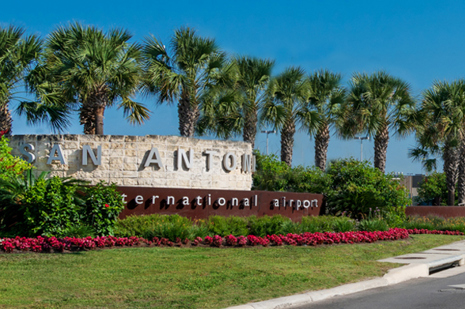
For Desiree Curtis, the IATA Aviation Security Management Diploma has provided multiple new perspectives at the forefront of current thinking, fueling her projects and results.
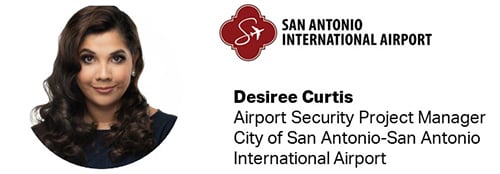
Responsible for developing various initiatives to advance the airport’s ability to proactively manage threats, including the Security Management System (SeMS), the Airport Cybersecurity Program, and the Human Trafficking Program. San Antonio International Airport is one of two airports owned and operated by the City of San Antonio. Its two terminals serve 11 domestic and international airlines transporting some 7 million passengers and 120,000 tonnes of cargo.
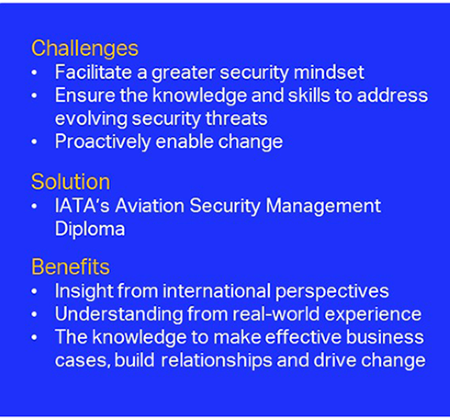
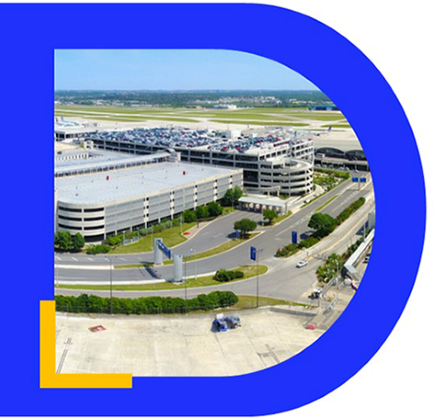
As a child, I dreamed of being an astronaut and started learning to fly in high school. My destiny was not, ultimately, to take people to the stars or the sky, but I did learn that I wanted to be involved in some way in the aviation industry. It wasn’t easy to get into, even with a Bachelor’s and a Master’s in Aeronautical Science. I started at an entry level position as an Administrative Assistant at Stinson Municipal Airport in San Antonio. That gave me a good foundation since, in general aviation, you have a broad range of responsibilities: from wildlife management to airport operations, to emergency response, community engagement, and even budgeting. This experience opened doors for me in Airport Operations at San Antonio International Airport (SAT), and then back in Stinson Facilities Operations; such that I had a thorough grounding in every aspect of how an airport operates.
In 2016, I was promoted to Airport Security Project Manager at SAT, with a vision of implementing a Security Management System (SeMS). This was an exciting project which came as a result of the airport’s forward-thinking approach to enhancing the security culture. As I researched what would help the airport, IATA’s name kept coming up and I decided to go to the source for the best materials and resources. To do a quality job of designing our SeMS, taking the IATA Security Management Systems course was an obvious way to reach my goal, broaden my knowledge, and build my expertise from the Subject Matter Experts and fellow participants from around the world.
My overall mission at SAT is to facilitate a greater security mindset and ensure we, as an organization, continue to address an ever-evolving array of threats. With the full support of my organization, I chose to complete the full IATA Aviation Security Management Diploma, which endowed me with the diverse knowledge and skillsets to proactively enable change.
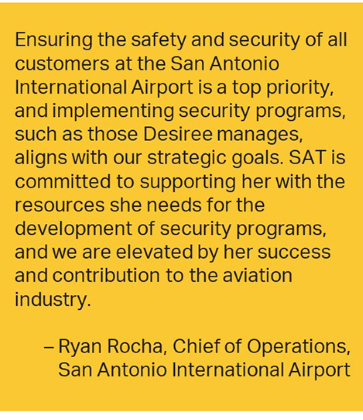
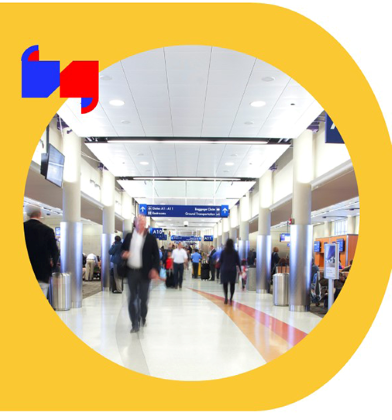
During the early stages of the project, I researched many comparable programs. Some were more certification-focused, giving the knowledge to respond in specific situations and comply with U.S. regulations. I wanted to have my thinking challenged, by different perspectives from around the world. Also, with the International Civil Aviation Organization (ICAO) standards, which may be integrated into the Federal Aviation Administration (FAA) regulations, I can begin to adapt before it is required.
This is when I chose to start the Aviation Security Management Diploma program in 2016 with the Security Management Systems course, and the Aviation Security Management and Security Risk and Crisis Management courses in the next two years. In 2020, everything came to a halt with the pandemic, but I was able to complete the Diploma via virtual classroom in 2021, with my final elective course in Aviation Cyber Security.
The instructors were fantastic! In the SeMS courses, the instructors exceeded my expectation with the vast experience and knowledge. I thought I was just getting an introductory guidance for initial design of the system, but they provided continuous support outside the classroom through the entire development process I also appreciated the cybersecurity course content which progressed my understanding and aided me in building synergies with other entities, which was great for a non-IT person.
Although I was actively looking to build my network, I did not expect the instructors to be part of that. Their availability and willingness to share their experience and knowledge has been so valuable, even now. The network I created with my cohort, which was truly international – I was one of only two people from the US – also enables me to tap into what is going on in other countries and other organizations.


My learning journey with IATA gave me a wealth of insight. In fact, I still refer to my notes all the time! Most importantly, IATA helped me validate the importance of focusing on people. First, hiring the right people and giving them the resources and training to be security minded. Armed with that insight, we were able to present the business case for restructuring our security division, which enabled us to solidify roles and responsibilities, and led to other initiatives, such as redefining our standard operating procedure and job descriptions, to enhance employee performance.
The training also helped engage the airport community on the important role individuals have in stopping human trafficking. For example, the security team placed awareness campaign posters throughout the airport to empower people to report if they see anything suspicious. We were also able to build relationships with subject matter experts from outside aviation, such as a human-trafficking survivor, who provided great insight into how to design bathroom signage that would reach victims and help us have a trauma-informed response.
Similarly, I also learned the importance of strengthening the relationship between aviation security and IT to maximize the effectiveness against cybersecurity threats. This insight and the understanding I’ve gained on the various risks and performing risk assessments helped break down communication challenges. The course provided me with a foundation to build synergy with IT professionals for integrating and expanding our resources to manage cyber threats. The Transportation Security Administration (TSA) just issued a cybersecurity National Amendment and with those relationships in place, it’s much easier to effect that change.
In fact, IATA has helped me to see the next direction I need to take in my career. I’m now pursuing a PhD in Leadership Studies, which examines how various leadership theories affect employee performance. I am looking to expand my studies to include research into the effect of organizational culture influencing employees’ behavior towards security policies.
That’s my main goal: to be able to influence change. I’m always looking at the next step, researching and networking to figure out the upcoming threats and determining the appropriate strategies. I’ve already started looking at what training IATA offers in management, leadership, policy-making and legislation, and once I have a better idea of what will have the biggest impact on airports and aviation as a whole. I’ll definitely be looking for more knowledge and insight from IATA Training.
Download the outline to explore the diploma, its objectives and key topics.